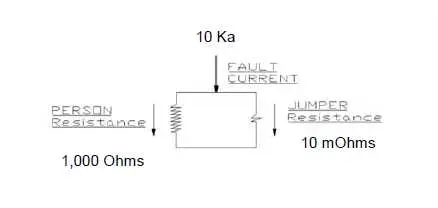A short-circuiting device does not and cannot prevent current flow in the human body, it can only limit the current flow. International
Safety Standards are designed to limit the current flow through the human body to a safe level in the event of accidental energising of the worksite. Limiting current flow to a safe level ensures that ventricular fibrillation does not occur and permanent heart damage is not caused.
Restriction of current flow and control of voltage across the human body is achieved by establishing the correct resistance ratio between the human body and short-circuit jumper. For example, a voltage applied to a 1,000 ohm resistor and a 1 ohm resistor in parallel will result in 1,000 times the current flow on the 1 ohm resistor compared to the 1,000 ohm resistor.
Similarly if a 10kA fault is applied to the sketch below where the person resistance is 1,000 ohms and the jumper resistance is
10 milliohms then 9,999.9 amps will flow through the jumper and restrict the current flow through the person to 0.1 amps (100
milliamps). This is an Internationally recognized safe level of current to pass through the human body. As the PD across the
jumper and the person is the same, Ohms Law applies.
Example: Voltage across jumper is V = IR = 10Ka x10 milliohms = 100 Volts,
therefore current flow through person is I = V/R = 100V/1000 Ohms = 100 milliamps.
If the jumper resistance increases above 10 milliohms less current will flow through the jumper and more current through the person’s
body. (2)
To emphasise the importance of resistance in a short-circuiting device, if the jumper resistance in the same example was 100 milliohms (which is still only 1/10 of an ohm) 9,999 amps would flow through the jumper instead of 9,999.9 amps. Consequently, 1 amp would flow through the person, this is 10 times the safe level of current flow through the human body and would almost certainly result in death.


